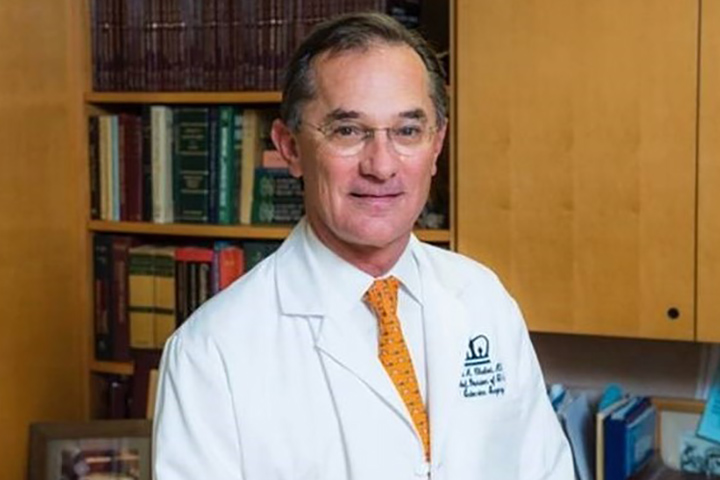Making Surgery An Option for More Pancreatic Cancer Patients

To cut is to cure.
For many malignant solid tumors this is the case. But it’s especially important for pancreatic cancer. Today, pancreatic cancer surgery, generally followed by a regimen of chemotherapy, is the only potentially curative treatment. Unfortunately, only a fraction of patients are eligible for surgery when they are first diagnosed. In most cases, the disease has advanced too far and removal of the primary tumor would not provide any benefit.
But new insights into pancreatic cancer treatments such as neoadjuvant therapy, sophisticated imaging, innovative highly-technical surgical approaches, and the expertise of a diverse medical specialty team are helping more patients become surgical candidates.
Is Surgery Possible?
Although pancreatic cancer patients are faced with many decisions, as well as the obvious life-altering diagnosis, getting a second surgical opinion, especially for cases of so-called borderline resectable or locally advanced pancreatic cancer, is vital. “The message we ultimately want to deliver is that if a patient does not have metastatic disease and you’ve been told by a surgeon they can’t get the tumor out, see another surgeon and make sure that’s true,” says Dr. John Chabot, one of the nation’s leading surgical oncologists and Executive Director of the Pancreas Center at New York-Presbyterian/Columbia. “We would like to see a ‘no’ become a ‘yes’ for some patients.”
To put this in perspective, at diagnosis more than half of patients have metastatic disease, meaning the tumor has spread outside of the pancreas. About 20 percent have early stage disease. Depending on overall health and other factors, these patients have surgery as a first line of treatment, and receive adjuvant (after surgery) chemotherapy. The remaining 25 to 30 percent of patients have traditionally fallen into a cohort of patients that were traditionally tough to treat surgically. Although the cancer had not yet spread outside of the pancreas to distant organs, the tumor was often deemed too difficult to remove. “These are the patients that have borderline resectable or locally advanced disease and it was very frustrating from a surgical perspective,” Chabot says. “We knew the tumor hadn’t spread, but we couldn’t get to it. It was challenging.”
But it’s a challenge that is in dire need of a potential solution. “There is no doubt that pancreatic cancer is tough to treat, but we are moving the needle in the right direction as we learn more about how we could potentially help these patients,” Chabot explains. “And too many patients with pancreatic cancer still aren’t getting the help they need. Some may never even meet with a surgeon, even if they are potential candidates.”
The Importance of an Experienced Pancreatic Team
Part of the issue facing patients may be access to an experienced pancreatic cancer medical team, all of whom are up-to-date on the latest inroads being made in treatment. “As a surgeon, the most frustrating scenario is when a borderline resectable patient sees a surgeon who doesn’t do much pancreatic cancer surgery and is told surgery is not an option and is denied a potentially curative approach because the surgeon doesn’t want to take a chance or doesn’t have the skill,” he says. Chabot sees second-opinion patients from all over the world.
“On the other end of the spectrum is a patient with complex locally advanced disease in which there is a lot of blood vessel involvement, and a patient is told surgery isn’t an option,” he adds. “Well, if given neoadjuvant treatment (treatment prior to surgery), such as chemotherapy and/or radiation, and with the right surgical team, surgery may indeed prove to be an option.” The goal of neoadjuvant treatment in these cases is potentially to shrink tumors, making them more amenable to surgery with negative margins—meaning no cancer cells have been left behind. Although vascular involvement (a tumor encroaching or growing into the superior mesenteric or portal vein) was considered a contraindication to surgery, today these veins may be resected partially and reconstruction may be possible, depending on several factors.
To be clear, there are patients for whom surgery is not appropriate. Those with metastatic disease will not benefit from surgery, and those with other major illnesses or poor performance status are not candidates. “Sometimes there are still tumors that we know we can’t get out,” Chabot says. “What is important is to be sure your tumor cannot be removed.”
Turning a “No” into a Potential “Yes”
To make surgery an option for more pancreatic cancer patients, Chabot and colleagues at Columbia/New York Presbyterian Hospital have developed a multidisciplinary approach, and have more than a decade of experience in treating these formerly “inoperable” patients.
“We started off slow with the most perfect of patients, then we moved on to a more general group, and now nearly all patients with borderline and many with locally advanced disease get surgery,” he explains, adding that the most important aspects of successful surgery are not only removal of the primary tumor with negative margins, but also removal of associated lymph nodes, low complication rates, and improved survival.
Post-operative statistics are moving in the right direction, too. “In patients who are appropriate candidates, the cure rates here are almost identical to those who are clearly surgical candidates at diagnosis,” Chabot says. “We’ve just about tripled the number of patients who might have a shot at being cured. In the past, we could maybe perform surgery on 15 percent of patients, now we can operate on 40 to 50 percent of patients. Even if we aren’t curing them, we can try to provide the opportunity for a cure or for longer survival. And for a disease like pancreatic cancer that is so very important.”
But patient recovery can be extensive, and depending on the operative approach, can take several months. Chabot notes that most patients do well because of excellent post-operative care. He emphasizes that patients should seek second surgical opinions at so-called high-volume centers, meaning those centers that treat high numbers of pancreatic cancer patients through a multidisciplinary approach.
“To say these surgeries are easy and recovery is easy is not the message. The message is don’t take the first ‘no’ and think you are out of options,” he adds. “What we know is that pancreatic cancer requires a team of experts from surgery, gastroenterology, medical oncology, radiation, radiation oncology, genetics, nutrition, and others, like counselors. Every person on that team will play a role in how well a patient does.”
“I’ve been at this a while, and what I’ve learned is that pancreatic cancer is aggressive, and we need to be aggressive.”






